Hello All,
New member here with very little pool experience. Hoping to get some input on an issue I'm having with the fiberglass.
We purchased our home in 2021 and it came with a roughly 12ft x 14ft x 2ft fiberglass pool that was installed in 2017. I'm told it's called a "plunge pool". I've estimated it to be about 1700 gallons. The pool has a cartridge filter, in-line chlorine feeder, and also a heater to allow the small pool to function as a hot tub if desired. The previous owner apparently never drained the pool and it does not have a cover. So during the winter, water was pumped out to a lower level (just above the inlets to keep weight on the pool), the lines blown out, pool antifreeze added, inlets capped, and power to system turned off. None of this may be relevant, but trying to provide any relevant back story to what issue developed.
Last year before closing for the winter, I started to notice a white buildup on what I thought was just around the water line. In my ignorance, i figured I'd just let it go and address it this spring when opening. I opened the pool in May this year and after getting the chemicals lined out, turned on the heater, and the wife and I got in it on a Friday night. The next morning when I came out to look at the pool, enough water had evaporated, that I could clearly see what looked like a thick white buildup as if someone had painted the pool white. I googled for hours trying to figure out what to do and eventually had a local pool company come out to look at it. The guy that came out tried muriatic acid and it did nothing. His recommendation (which I disagreed with) was to take a wire brush to the build up. I contacted another local company and after testing, they believed that my pool had so little calcium in it (to my ignorance, last summer I'd been filling with our hose that comes from a water softener) that the water was pulling from wherever it could to regain calcium. They also thought the alkalinity could have been very high over a number of years and causing this scale buildup to occur. Additionally, we confirmed the white buildup covers the ENTIRE pool below the water line including the floor. Their suggestion was to begin wet sanding the entire pool with 1000-1500 grit sandpaper.
I began taking this task on my own and eventually moved to 400 and 800 grit wet sandpaper so that I could make quicker progress while also trying to make sure I wasn't getting too deep/aggressive with the sanding. I'm about 20 hours into it and still have to do the entire floor. I basically have been keep 3-4 inches of water in the pool, sanding the walls, then when the water gets milky white from the sanding, drain it out and refill with fresh water, then repeat the process. The walls at this point pretty much have the buildup removed but are now all greyed over and smeared with white stuff. It's difficult to tell if this is the haze/smearing of the scale buildup or if I've gone too far into a layer of gelcoat and i'm smearing around gelcoat at this point. I don't have any previous experience working with fiberglass so unfortunately am winging it a bit. I called the 2nd pool company again to get their opinion and their recommendation was to now go over the walls with 2000 grit wet sandpaper and then take a mechanical buffer and compound and go over a 2ft x 2ft area to see if it'd remove the gray haze and bringing back some of the luster and shine. If that works, do that to the rest of the pool. If it doesn't, we may be looking at stripping and applying new gelcoast. This buffer concept makes some sense to me, but in my googling I really can't find any examples or solutions of people using a buffer and compound on a fiberglass pool. I can only find use cases for using it on boats, RV's, and water slides.
So my overall question is, does it make sense to proceed with a buffer at this point? Is there a recommended buffering/rubbing compound to use on a pool that's safe to use? I see there's compounds specifically meant for Marine and RV and I can also find examples online of people using 3M Marine rubbing compound and Wax combinations on water park slides. My concern is applying chemicals to the pool walls that will leave behind a residue that may be unsafe for swimmers even if it does restore the shine and gelcoat appearance.
Sorry for the rambling description of the issue but any suggestions would be appreciated. I've attached some before pictures and pictures of where I'm at now. The water level all summer last year was right at where the top of the white line is. I drained it down a few inches to confirm the scale was not just the at the water level and take the before pictures. I still need to figure out how to best handle the top of the step and floor since it's got a textured anti-slip coating on it, making it difficult to sand.
Thanks in advance for any input!
New member here with very little pool experience. Hoping to get some input on an issue I'm having with the fiberglass.
We purchased our home in 2021 and it came with a roughly 12ft x 14ft x 2ft fiberglass pool that was installed in 2017. I'm told it's called a "plunge pool". I've estimated it to be about 1700 gallons. The pool has a cartridge filter, in-line chlorine feeder, and also a heater to allow the small pool to function as a hot tub if desired. The previous owner apparently never drained the pool and it does not have a cover. So during the winter, water was pumped out to a lower level (just above the inlets to keep weight on the pool), the lines blown out, pool antifreeze added, inlets capped, and power to system turned off. None of this may be relevant, but trying to provide any relevant back story to what issue developed.
Last year before closing for the winter, I started to notice a white buildup on what I thought was just around the water line. In my ignorance, i figured I'd just let it go and address it this spring when opening. I opened the pool in May this year and after getting the chemicals lined out, turned on the heater, and the wife and I got in it on a Friday night. The next morning when I came out to look at the pool, enough water had evaporated, that I could clearly see what looked like a thick white buildup as if someone had painted the pool white. I googled for hours trying to figure out what to do and eventually had a local pool company come out to look at it. The guy that came out tried muriatic acid and it did nothing. His recommendation (which I disagreed with) was to take a wire brush to the build up. I contacted another local company and after testing, they believed that my pool had so little calcium in it (to my ignorance, last summer I'd been filling with our hose that comes from a water softener) that the water was pulling from wherever it could to regain calcium. They also thought the alkalinity could have been very high over a number of years and causing this scale buildup to occur. Additionally, we confirmed the white buildup covers the ENTIRE pool below the water line including the floor. Their suggestion was to begin wet sanding the entire pool with 1000-1500 grit sandpaper.
I began taking this task on my own and eventually moved to 400 and 800 grit wet sandpaper so that I could make quicker progress while also trying to make sure I wasn't getting too deep/aggressive with the sanding. I'm about 20 hours into it and still have to do the entire floor. I basically have been keep 3-4 inches of water in the pool, sanding the walls, then when the water gets milky white from the sanding, drain it out and refill with fresh water, then repeat the process. The walls at this point pretty much have the buildup removed but are now all greyed over and smeared with white stuff. It's difficult to tell if this is the haze/smearing of the scale buildup or if I've gone too far into a layer of gelcoat and i'm smearing around gelcoat at this point. I don't have any previous experience working with fiberglass so unfortunately am winging it a bit. I called the 2nd pool company again to get their opinion and their recommendation was to now go over the walls with 2000 grit wet sandpaper and then take a mechanical buffer and compound and go over a 2ft x 2ft area to see if it'd remove the gray haze and bringing back some of the luster and shine. If that works, do that to the rest of the pool. If it doesn't, we may be looking at stripping and applying new gelcoast. This buffer concept makes some sense to me, but in my googling I really can't find any examples or solutions of people using a buffer and compound on a fiberglass pool. I can only find use cases for using it on boats, RV's, and water slides.
So my overall question is, does it make sense to proceed with a buffer at this point? Is there a recommended buffering/rubbing compound to use on a pool that's safe to use? I see there's compounds specifically meant for Marine and RV and I can also find examples online of people using 3M Marine rubbing compound and Wax combinations on water park slides. My concern is applying chemicals to the pool walls that will leave behind a residue that may be unsafe for swimmers even if it does restore the shine and gelcoat appearance.
Sorry for the rambling description of the issue but any suggestions would be appreciated. I've attached some before pictures and pictures of where I'm at now. The water level all summer last year was right at where the top of the white line is. I drained it down a few inches to confirm the scale was not just the at the water level and take the before pictures. I still need to figure out how to best handle the top of the step and floor since it's got a textured anti-slip coating on it, making it difficult to sand.
Thanks in advance for any input!
Attachments
-
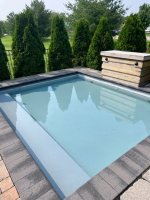 70602921967__38627846-BD45-4A4F-8DE8-449C1701B096.jpg67.5 KB · Views: 19
70602921967__38627846-BD45-4A4F-8DE8-449C1701B096.jpg67.5 KB · Views: 19 -
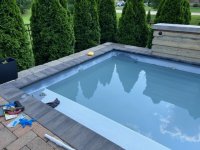 70604845955__8C748F06-D17C-4828-BF30-00B1B21A779D.jpg126.9 KB · Views: 14
70604845955__8C748F06-D17C-4828-BF30-00B1B21A779D.jpg126.9 KB · Views: 14 -
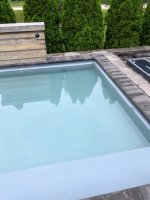 IMG_4916.jpg52.9 KB · Views: 13
IMG_4916.jpg52.9 KB · Views: 13 -
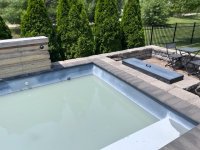 IMG_4959.jpg97.7 KB · Views: 13
IMG_4959.jpg97.7 KB · Views: 13 -
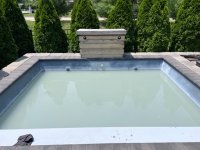 IMG_4960.jpg86.9 KB · Views: 14
IMG_4960.jpg86.9 KB · Views: 14 -
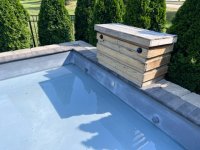 IMG_4986.jpg96.8 KB · Views: 18
IMG_4986.jpg96.8 KB · Views: 18 -
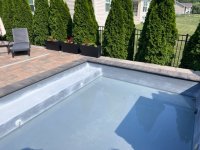 IMG_4987.jpg97.5 KB · Views: 17
IMG_4987.jpg97.5 KB · Views: 17 -
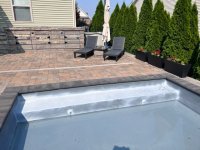 IMG_4988.jpg97.6 KB · Views: 20
IMG_4988.jpg97.6 KB · Views: 20
Last edited:


